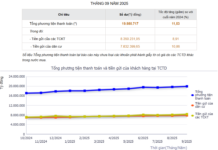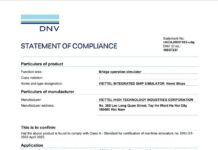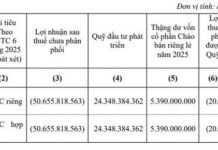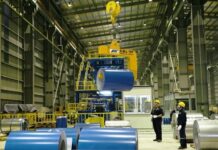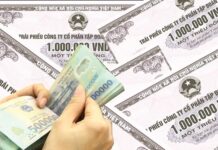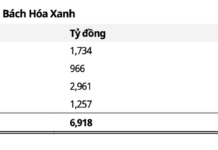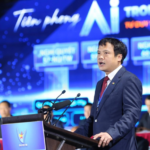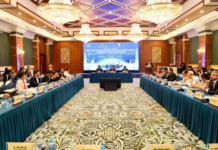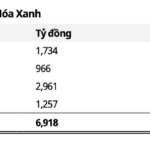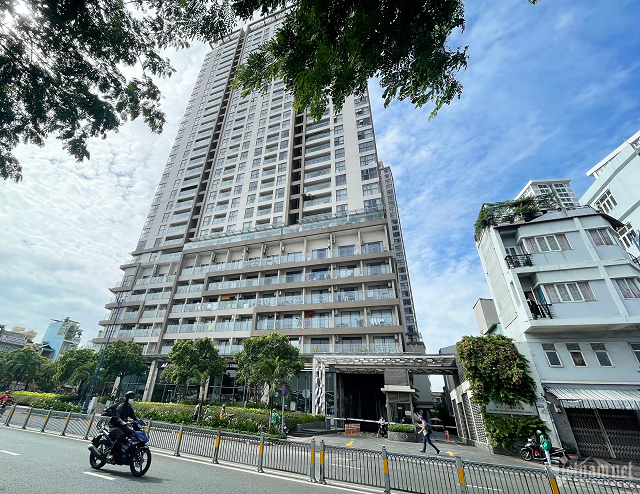Why Can’t State-Owned Enterprises Take Flight?
Before the private sector was recognized as the “most important driving force of the economy,” the state-owned sector, encompassing all national resources and state-owned enterprises (SOEs), played a leading role in strategic areas such as telecommunications (Viettel, MobiFone, VNPT), food (Vinafood I, Vinafood II), energy (EVN, PVN, Petrolimex), infrastructure (ACV, Saigon Port), and transportation (Vietnam Airlines).
Among these, Viettel has fully mastered the equipment in the 5G ecosystem and exports high-tech products to international markets. It also supports various ministries, sectors, and localities in three key areas: digital government, digital economy, and digital society.
However, aside from a few entities, most SOEs in key sectors operate in a closed manner, limiting opportunities for other businesses to participate in production and supply chains, according to Ms. Nguyễn Thu Thủy, Deputy Director of the State-Owned Enterprise Development Agency (Ministry of Finance).
Furthermore, despite managing total assets worth over 4.3 trillion VND (excluding state assets in Vietcombank, BIDV, VietinBank, and Agribank), the overall investment level of SOEs remains low, failing to fully leverage their role as a growth driver. According to the Ministry of Finance’s report, the total investment capital for 2024 by 19 state-owned corporations and groups is 160 trillion VND. Notably, EVN alone accounts for over 70% of this total, with 112.892 trillion VND.
Explaining this, Mr. Nguyễn Đình Tuấn, Deputy General Director of MobiFone, candidly admitted, “I envy how CMC makes investment decisions in just a few moments.” While a private company like CMC took only one month to decide on building three data centers, SOEs must go through lengthy planning processes. They must also quantify various factors, such as ‘what needs to be done in the next 1-3 years?’ and ‘which authorities need to approve it?’
“For manufacturing or energy companies, plans can be quantified. But for technology firms, much value lies in the ideas and vision of leaders, making quantification difficult. In technology, a delay of just six months can set you back,” Mr. Tuấn noted.
Not just Mr. Tuấn, at a recent forum on enhancing the competitiveness of SOEs, Mr. Chử Đức Hoàng, Chief of Office at the National Technology Innovation Fund (Ministry of Science and Technology – MOST), even wished SOEs and their leaders “success in spending on science, technology, innovation, and digital transformation.” This comes as legal frameworks like Resolution 57 and the Law on Science, Technology, and Innovation (ST&I) have emerged, promoting a “development-oriented” mindset over “administrative management.”
Ms. Hà Thị Thu Hằng, Deputy Head of Planning and Development at Vietnam Airlines, also lamented the lengthy investment approval process. For instance, aircraft manufacturers require large orders to offer better prices. However, the investment proposal for developing a narrow-body aircraft fleet, submitted before the Covid-19 pandemic, has only recently been approved.
Regarding green practices, Vietnam Airlines must offset carbon emissions for international flights but has yet to receive specific guidance or support from domestic regulatory bodies.
What Can SOEs Do to Lead in Science and Technology Development?
In reality, the draft Political Report for the 14th National Party Congress emphasized the integration of science and technology with the economy, stating, “Developing science and technology is a breakthrough task and a prerequisite for Vietnam to transition to a knowledge-based economy.”
Additionally, policies like Resolution 57, the ST&I Law, the Draft Law on Artificial Intelligence, and the Draft Law on Digital Transformation are under discussion. These include provisions such as sandbox mechanisms, substantial autonomy, and allocating at least 1% of the annual state budget (25 trillion VND) for digital transformation in strategic areas like AI, semiconductors, and digital platforms. These create a “golden opportunity” for SOEs to lead innovation.
In the broader landscape of technological innovation, leading brands remain state-owned economic groups, such as VNPT developing Vietnamese GenAI platforms and Viettel mastering Made-in-Vietnam 5G technology and core telecom equipment.
 A tourism entrepreneur in Hoi An explores technology applications developed by VNPT. Photo: Nhân Tâm |
To enhance the role of SOEs and the state-owned economy in driving sustainable double-digit growth, Dr. Chử Đức Hoàng suggests urgently issuing a new resolution on SOEs. He also advocates for a management mindset shift toward “responsible decentralization” and “allowing innovation experimentation.”
Breakthrough technologies like generative AI, blockchain, and biotechnology could be deployed in controlled environments for 12-24 months. SOEs should be granted genuine financial autonomy under the 2025 ST&I Law, with clear KPI-based targets and no micro-management interference.
“Focus on output monitoring rather than process control, and ensure transparent accountability for unmet goals to foster strong innovation incentives,” Mr. Hoàng advised.
Additionally, the Party and State should task SOEs with mastering strategic technologies, including AI, semiconductors, 5G/6G networks, clean energy, and biotechnology. Special mechanisms should be provided for sectors like defense, security, and critical infrastructure to ensure stable, long-term resources for core technology development.
From a business perspective, Mr. Nguyễn Đình Tuấn and Ms. Hà Thị Thu Hằng emphasize the need for mechanisms allowing leaders to make quicker decisions on internal matters. Clearer guidelines on ownership structures, especially when both the Ministry of Finance and SCIC represent capital, are essential to avoid governance confusion, particularly in long-term investment projects.
Mr. Lưu Trung Thái, Chairman of MB’s Board of Directors, stresses the importance of adopting technology company mindsets and methods when digitizing business operations. He also advocates for allowing SOEs to offer salaries comparable to private enterprises.
MB has invested approximately $100 million annually in technology for seven consecutive years, aiming to apply the latest innovations to quickly acquire customers.
“Over the past five years, the bank has gained 5-7 million new customers annually, leading the market in transaction volume and new customer acquisition. This has emboldened us to seek shareholder approval for significant technology investments and enhanced personnel efforts in digital transformation and data management,” Mr. Thái shared at a conference themed “SOEs Leading Digital Transformation and Growth Promotion.”
Vân Phong
– 07:00 28/11/2025
Ho Chi Minh City Plans Comprehensive Survey on Smart City Standards
Mr. Lam Dinh Thang, Director of the Ho Chi Minh City Department of Science and Technology, announced that following the Autumn Economic Forum 2025, the city will engage with experts in specialized areas such as urban governance and smart city development. Ho Chi Minh City plans to conduct a comprehensive survey across all wards, communes, and special zones.
Foxconn Skyrockets Revenue by 83% with AI, While Vietnamese Businesses Still Crown Excel as King
Amidst the backdrop of tech giants achieving record-breaking performance through automation, the critical challenge of positioning Vietnamese enterprises within the global value chain and crafting a feasible digital transformation roadmap for SMEs has taken center stage. This discourse is fueled by concerns that Vietnam may remain perpetually confined to a manufacturing and outsourcing role.






